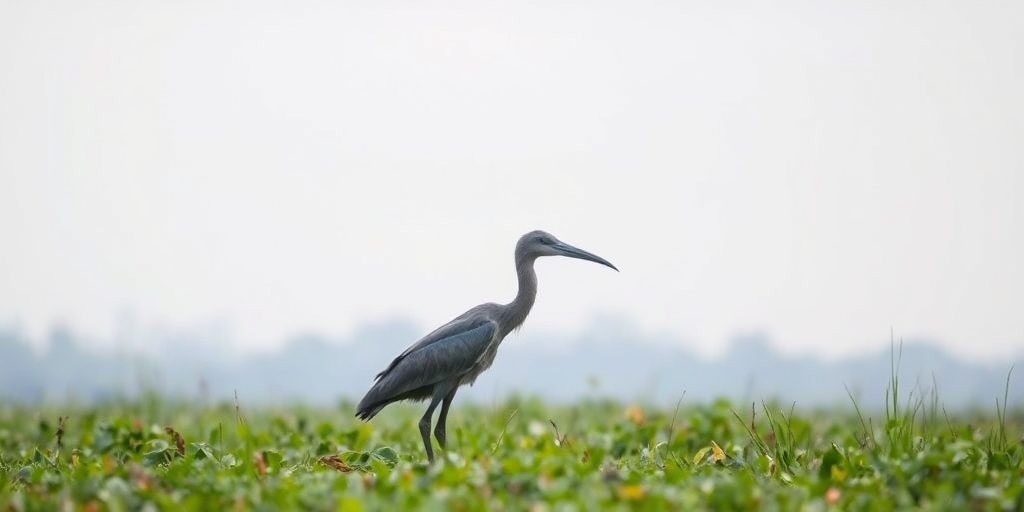Is it possible for a living bird to evoke images of prehistoric giants? The shoebill, renowned for its imposing stature and uniquely oversized bill, has become a subject of fascination among ornithologists and backyard bird enthusiasts. This article scrutinizes its distinctive physical features, explores specialized swamp habitats, and reviews its singular feeding strategies. In addition, it presents evolutionary insights and examines current conservation challenges. Through meticulous analysis, the post affirms that the shoebill continues to charm fans and fuel research with its enigmatic, dinosaur-like allure.
Habitat and Distribution of The Shoebill: Africa’s Dinosaur-like Bird Across African Swamps
The shoebill occupies a specialized niche within Africa’s freshwater ecosystems, primarily confined to eastern regions spanning from Sudan to Zambia. These vast swamps offer an ideal environment marked by slow-moving waters, dense aquatic vegetation, and nutrient-rich mud that supports both prey availability and secure resting locales. Occasional sightings as far west as the Congo River underscore its capacity to adapt within various freshwater settings while maintaining a strong endemic presence.
Adaptations for marsh life are integral to its survival strategy. Exceptional feet featuring a middle toe that can reach up to 18 centimeters play a key role in providing stability on floating debris and uneven wetland floors. This adaptation enhances the bird’s ability to forage and remain motionless in areas where water levels and vegetation density fluctuate. Ongoing decline in these critical habitats raises conservation concerns, as environmental changes threaten the integrity of the biodiverse wetlands that support complex ecological interactions.
- Endemic distribution across eastern Africa
- Swamp environment spanning from Sudan to Zambia
- Occasional presence near the Congo River
- Specialized feet with a middle toe up to 18 centimeters for balance
Regional hydrological patterns, vegetation cover, and water quality further delineate its ecological niche. Habitat degradation in these freshwater bio-regions directly impacts the shoebill, highlighting the necessity for focused research and conservation strategies to maintain the delicate balance of these critical ecosystems.
Dinosaur-Like Adaptations and Evolutionary Insights of The Shoebill: Africa’s Dinosaur-like Bird

The morphology of Balaeniceps rex offers compelling evidence of retained ancestral traits. Its massive, ancient rostrum mirrors adaptations observed in early avian dinosaurs, while leg structures reminiscent of ostriches and cassowaries underscore an evolutionary design that facilitates dynamic movement in wetland environments. Fossil record analyses correlate the bird’s distinct skeletal structures with ancient lineages, suggesting an evolutionary trajectory that conserves features once common among prehistoric species.
Comparative studies substantiate that the shoebill’s rostrum, with its pronounced curvature and robust build, functions in a manner consistent with fossilized raptor analogs. Evolutionary biology breakthroughs explain that subtle variations in bone density and joint configuration directly influence its functionality and striking appearance. This fusion of ancient proboscis design and distinctive leg morphology illustrates a singular adaptation supporting both ambush predation and efficient locomotion across challenging aquatic terrains.
- Ancient rostrum design reflecting early dinosaur-like traits
- Leg features analogous to those of ostriches and cassowaries
- Fossil correlations reinforcing connections to prehistoric lineages
- Bone structure variations indicating evolutionary breakthroughs
Comparative raptor investigations demonstrate that the shoebill’s anatomical specializations consolidate its image as a prehistoric icon. Advanced morphological assessments reveal that structural modifications, including specialized joint articulations and a robust beak, have evolved as direct responses to ecological demands. This focused analysis corroborates fossil record insights and deepens scientific understanding of its ancient lineage. These adaptations continue to intrigue ornithologists worldwide.
Final Words
in the action, the article explored the shoebill’s distinct taxonomy, physical features, and evolutionary traits.
It outlined the bird’s specialized habitat, foraging behaviors, and striking adaptations that evoke a prehistoric appearance.
The review also examined current conservation measures and research efforts addressing habitat decline and population challenges.
The Shoebill: Africa’s Dinosaur-like Bird remains an emblem of ancient biodiversity, inspiring ongoing inquiry and optimistic preservation efforts for future generations.
FAQ
Q: How tall is a shoebill stork?
A: The shoebill stork reaches heights up to 152 centimeters (5 feet), with a wingspan between 230-260 centimeters. Their large size contrasts with their relatively light weight of 4-7 kilograms.
Q: Where do shoebill storks live?
A: Shoebill storks inhabit eastern African swamps, ranging from Sudan to Zambia. Their primary habitat extends along the Congo River, where they occupy freshwater marshes and wetlands.
Q: What do shoebill storks eat?
A: Shoebill storks capture lungfish, frogs, snakes, lizards, and occasionally young crocodiles. They use their massive bill to hunt prey in dense marsh vegetation.
Q: How dangerous are shoebill storks?
A: Shoebill storks possess powerful beaks capable of decapitating prey, but they do not typically attack humans. They maintain solitary, territorial behavior and prefer avoiding human contact.
Q: Why do shoebills look like dinosaurs?
A: Shoebills display dinosaur-like features including an ancient-looking rostrum, ostrich-like legs, and a stork-like body. Their unique morphology preserves ancestral traits from prehistoric avian species.
Q: Are shoebills endangered?
A: Shoebills are classified as vulnerable, with approximately 5,000 individuals remaining. Between 50-80% of the population lives in South Sudan, facing threats from habitat destruction and hunting.


